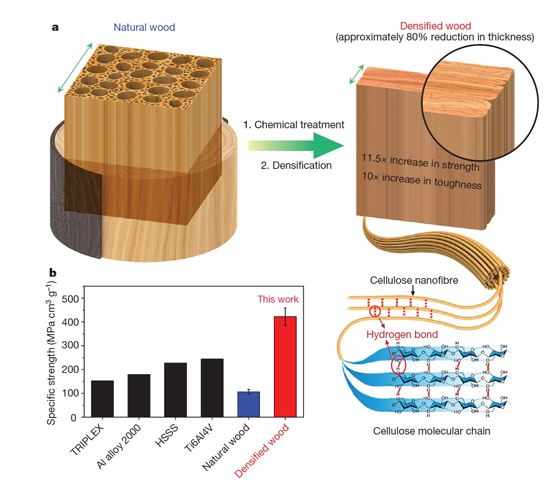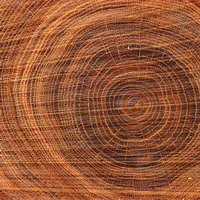Carbon preserving use of forest wood
The European forest is particularly at risk from climate change. In the two years 2018 and 2019 alone, over 150 million cubic meters of wood were lost in Germany due to the bark beetle, drought and storm damage. The amount of biologically bound carbon that is going to be released during the rotting of the wood corresponds to about 10% of Germany's annual CO2 emissions. Millions of new trees must be planted to compensate for the damage. But in addition to the undoubtedly important task of creating new forests and closing gaps, it is becoming an increasingly important national task to protect the existing forests and to develop carbon-conserving wood uses.
If a tree is cut and all its wood is used to obtain a material in which the carbon assimilated by the tree is stored for an extended period (e.g. a roof beam, a shipping container made of densified wood or biochar), and if during this period of wood using a new tree grows in the same place in the forest, the amount of CO2 that was eventually removed from the atmosphere doubled (the carbon in the newly grown tree plus the carbon in the building material that was obtained from the felled tree). However, if the wood is not used as an industrial material, but burned or left to decompose in the forest, the carbon balance is at best neutral. However, this carbon-neutral status is only obtained after about 70 years, when the felled, chopped and burned tree’s replacement has grown.
The climate service (C-sink performance) potential of forests can only be fully leveraged when the carbon that the forest has extracted from the atmosphere via photosynthesis is permanently stored in long-lasting wood-based materials or as biochar in the soil. Therefore, new materials using wood must be developed urgently and scaled-up industrially. In order to use fallen timber in a way that prevents it from becoming a massive source of new greenhouse gas emissions, it must be removed from the forest and transformed into sustainable industrial products.
Even though the burning of biomass to generate electricity and heat is subsidized by the state because it is classified as renewable energy, all burning of biomass destroys a natural carbon store. In fact, the burning of tree and shrub wood is just as harmful to the climate as the burning of fossil resources (Searchinger et al., 2018). In order to save the climate, not only the burning of fossil carbon but also the burning of biomass (without CCS) must be prevented. The biomass should instead be used for building carbon sinks in the form of industrial materials.
Wood is not only an excellent carbon repository, but it is one of the noblest and versatile materials on earth. Just about everything can be made from wood that was previously reserved for petrochemicals (petroleum-based chemistry), including plastic, pharmaceuticals, rubber or batteries. With new wood densification technology, wood materials can now even replace steel, concrete, carbon fiber composites and even glass.
Densified wood is stronger and more stable than steel
A new technical method allows wood to be densified in such a way that components can be shaped in any form and have higher compressive and tensile strength than titanium steel and carbon fiber composites (Song et al., 2018). In the process, wooden boards are first cooked in an alkaline solution (e.g. NaOH - Na2SO3), whereby about half of the hemicellulose and lignin are removed from the wood. What remains are mostly cellulose nanofibers which can then be densified. By compressing the cellulose fibers under the influence of steam at 100 ° C with about 5 MPa (50 atmospheres), hydrogen bonds are formed between the molecular chains of the cellulose. The cellulose fibers thus become extremely strongly bonded with one another. The volume of the wood shrinks about five times.

Figure 1 | Processing approach and mechanical performance of densified wood (Song et al., 2018).
(a) Schematic of the top-down two-step approach to transforming bulk natural wood directly into super-strong and tough densified wood. Step 1, chemical treatment to partially remove lignin/hemicellulose; step 2, mechanical hot-pressing at 100 °C, which leads to a reduction in thickness of about 80%. Most of the densified wood consists of well-aligned cellulose nanofibers, which greatly enhance hydrogen bond formation among neighboring nanofibers.
(b), Specific tensile strength of the resulting densified wood (422.2 Å} 36.3 MPa cm3 g−1, mean Å} standard deviation) is shown to be higher than those of typical metals (the Fe-Al-Mn-C alloy, TRIPLEX, and high specific strength steel, HSSS), and even of lightweight titanium alloy (Ti6Al4V).
The densified wood is an extremely stable, scratch-resistant, and water-repellent material. With a suitable coating, the densified wood does not absorb water. The densified wood is corrosion-resistant and a good heat insulator. In addition to the significantly higher strength and the much lower specific weight, the material has other significant advantages compared to the metal sheets commonly used e.g. in auto-body construction.

Figure 2. Delignification of native wood (a) results in a white cellulose scaffold (b). Densification of the delignified cellulose scaffold (c) results in a homogenous folding of the earlywood cells. (Frey et al., 2018)
The material properties and strengths of the densified wood would make it suitable for the construction of car body panels, car interior cladding as well as for the load-bearing chassis. Even the wheel rims could be made from this transformed biological material.
Beech, spruce, poplar or any other log from the global forest can be used as the precursor material for densified wood (Song et al., 2018).
Biochar use of wood waste from densified wood fabrication
Bark, sawdust and wood surplus that are produced when the trees are processed into densified wood panels can be pyrolyzed. This process produces biochar and pyrolysis oil (Schmidt et al., 2018). The biochar could be finely ground as a 2-5% additive in the textiles of the interior of cars, which helps provide a pleasant indoor climate. Biochar and pyrolysis oil could also be used as an asphalt additive in road construction, as building material or for agricultural purposes. The good portion of the carbon that was originally extracted by the tree from the atmosphere would thus remain stable in the terrestrial system for many centuries.
The extracted hemicellulose could be used to make nylon or fuel, and the lignin is a raw material for artificial wood, carbon foam, composite materials, and bioplastics (for an overview see: here)
Cars as mobile carbon sink
To access the enormous potential of wood, industrial pioneers who recognize the potential and market advantage of natural carbon-storing materials are needed. A car manufacturer, for example, who is willing to break with the conventions of steel and plastic, could, beyond changing the combustion engine for an electric one, shape the car culture of the future.
Depending on size and type, between 5 and 10 t CO2 are currently emitted to produce a single car. If the car were to be built with biogenic materials from the inside out, a carbon sink of over 1 t CO2eq could be obtained factoring an empty weight of 1.5 t and deducting the non-biogenic materials (engines) and the carbon footprint from material provision and manufacturing.
The (rustproof) car would thus become a mobile carbon sink. At the end of the car’s life cycle, all densified wood that has been installed in the car can be chopped and then pyrolyzed, with the majority of the carbon being preserved. The resulting biochar is a valuable soil aid in gardening and agriculture or can be used to improve housing insulation. Most of the carbon that was stored in the wood-based materials of the car would thus remain in floors and walls or other products for centuries to come. It would not return to the atmosphere as CO2.
If the current fleet of 1.25 billion cars were replaced with this bio-based technology, around 1 Gt CO2eq could be sequestered, which corresponds to approx. 3% of the worldwide CO2eq emissions.
State of the development
The basic process of densifying wood as described above has been known for over 15 years. However, the scientific framework for industrial uses has only been developed in the last five years. Research projects at the University of Maryland, KTH Stockholm and ETH Zurich are particularly worth mentioning (Li et al., 2016; Frey et al., 2018; Song et al., 2018). A number of patents that protect the technology already exist. To our knowledge, industrial applications have not yet been implemented. The technical challenges for the implementation and scaling of this technology seem rather manageable. The basics of the technology are sufficiently developed that a company with appropriate research and development capacities could tackle a pilot project to build a recyclable carbon sink car.
Freight containers and other C-sink products made of densified wood
As a pilot project, the production of a carbon sink car would undoubtedly ensure a global media echo. It would not only demonstrate the potential of the new technology but would also show how our modern consumer society might maintain its standard of living if virtually all industrial products become carbon sinks and are completely recyclable. On the way towards the new C-sink industry, there are, of course, a number of simpler industrial products than cars that could be realized faster and with lower development costs. The design and manufacture of freight containers from densified wood should serve here as an example.
A 40-foot steel freight container weighs approx. 4 t and causes an average of 8 t CO2eq emissions during its manufacture. Due to the accelerated corrosion, especially by seawater, the lifespan of the average containers is a mere 15 years (Buchanan et al., 2018). A further 1.2 t CO2eq is then incurred for melting and recycling the steel (Obrecht & Knez, 2017). If the containers were made of densified wood instead of steel and the weight was reduced by 25%, the wood of each container would contain 1.5 t carbon (5.5 t CO2eq) as a C-sink. The weight saving could also decrease the fuel required for freight transport by 20%, which would correspond to around 30 t CO2eq per 40 foot container over 15 years using today's fuel consumption as the basis for calculation (Buchanan et al., 2018). Overall, the use of densified wood for the construction of freight containers would save around 45 t CO2eq per 40-foot container over its lifecycle. Converting the current fleet of 18.6 million freight containers (10, 20 and 40-foot containers) worldwide to densified wood, savings of approx. 650 million t CO2eq could be obtained over 15 years.

Figure 3: The products of the consumer society are distributed across the globe in 18.6 million freight containers. If the containers were built from densified wood instead of steel, more than 650 million tons of CO2eq could be saved.
The freight containers made of densified wood would not only be more robust and at the same time lighter, but would also have other advantages: While the steel containers are coated with toxic rust inhibitors based on chromium, phosphorus, and lead, the densified wood, which due to its extreme compression absorbs only 3% water, requires only vegetable oil for protective impregnation. Since the wood does not rust, a significantly longer lifecycle than those of steel containers can be expected. At the end of the life cycle, the densified wood can be processed into biochar and bio-oil, as described in the case of cars, which would preserve most of the C-sink value of the material.
Another advantage of the containers made of densified wood is the much better thermal insulation, which could save considerable amounts of energy for cooling, especially when transporting food. Researchers at the University of Maryland have developed densified wood that reflects light in a way that it even actively cools the surface material (Li et al., 2019). The densified wood converts ambient radiation into medium-wave infrared radiation, whereby the surface emits heat. While the steel containers heat up quickly in the sun, densified wood containers would save over 50% energy for cooling, which is especially valuable for shipping lines running through the tropical belt (Li et al., 2019).
The example of ship containers shows the huge potential of transforming heavy industries into carbon sink product manufacturers while also offering numerous additional advantages (e.g. lower heating, cooling, material, and fuel costs). From computer housings, frames for solar panels, wind turbines, and corrosion-resistant bridges to replacing the iron armature in concrete buildings, densified wood could become a major driver of the bio-based economy, with every new product becoming a long-lasting C-sink. This, it seems, is the only economically viable way to balance the planet's carbon balance in the foreseeable future.
The motto for the next decade should, therefore, be:
Transforming industrial products into biogenic carbon sinks.
Literature
Buchanan CA, Charara M, Sullivan JL, Lewis GM, Keoleian GA. 2018. Lightweighting shipping containers: Life cycle impacts on multimodal freight transportation. Transportation Research Part D: Transport and Environment 62:418–432. DOI: 10.1016/J.TRD.2018.03.011.
Fang, C.-H., Mariotti, N., Cloutier, A., Koubaa, A. & Blanchet, P. Densification of wood veneers by compression combined with heat and steam. Eur. J. Wood Wood Prod. 70, 155–163 (2012).
Frey M, Widner D, Segmehl JS, Casdorff K, Keplinger T, Burgert I. 2018. Delignified and Densified Cellulose Bulk Materials with Excellent Tensile Properties for Sustainable Engineering. ACS Applied Materials & Interfaces 10:5030–5037. DOI: 10.1021/acsami.7b18646.
Hill, C. A. et al. The water vapour sorption properties of thermally modified and densified wood. J. Mater. Sci. 47, 3191–3197 (2012).
Kutnar, A. & Kamke, F. A. Compression of wood under saturated steam, superheated steam, and transient conditions at 150 °C, 160 °C, and 170 °C. Wood Sci. Technol. 46, 73–88 (2012).
Laine, K. et al. Measuring the thickness swelling and set-recovery of densified and thermally modified Scots pine solid wood. J. Mater. Sci. 48, 8530–8538 (2013).
Laine, K., Segerholm, K., Wålinder, M., Rautkari, L. & Hughes, M. Wood densification and thermal modification: hardness, set-recovery and micromorphology. Wood Sci. Technol. 50, 883–894 (2016).
Li Y, Fu Q, Yu S, Yan M, Berglund L. 2016. Optically Transparent Wood from a Nanoporous Cellulosic Template: Combining Functional and Structural Performance. Biomacromolecules 17:1358–1364. DOI: 10.1021/acs.biomac.6b00145.
Li T, Zhai Y, He S, Gan W, Wei Z, Heidarinejad M, Dalgo D, Mi R, Zhao X, Song J, Dai J, Chen C, Aili A, Vellore A, Martini A, Yang R, Srebric J, Yin X, Hu L. 2019. A radiative cooling structural material. Science (New York, N.Y.) 364:760–763. DOI: 10.1126/science.aau9101.
Navi, P. & Heger, F. Combined densification and thermo-hydro-mechanical processing of wood. MRS Bull. 29, 332–336 (2004).
Obrecht M, Knez M. 2017. Carbon and resource savings of different cargo container designs. Journal of Cleaner Production 155:151–156. DOI: 10.1016/J.JCLEPRO.2016.11.076.
Schmidt H-P, Anca-Couce A, Hagemann N, Werner C, Gerten D, Lucht W, Kammann C. 2018. Pyrogenic carbon capture and storage. GCB Bioenergy. DOI: 10.1111/gcbb.12553.
Searchinger TD, Beringer T, Holtsmark B, Kammen DM, Lambin EF, Lucht W, Raven P, van Ypersele J-P. 2018. Europe’s renewable energy directive poised to harm global forests. Nature Communications 9:3741. DOI: 10.1038/s41467-018-06175-4.
Song J, Chen C, Zhu S, Zhu M, Dai J, Ray U, Li Y, Kuang Y, Li Y, Quispe N, Yao Y, Gong A, Leiste UH, Bruck HA, Zhu JY, Vellore A, Li H, Minus ML, Jia Z, Martini A, Li T, Hu L. 2018. Processing bulk natural wood into a high-performance structural material. Nature 554:224–228. DOI: 10.1038/nature25476.


How about bamboo biochar?
Several Countries have BAMBOO Forests. We have not read any information regarding Bamboo being subjected to the recent methods of carbon sink accreditation. derick calderon